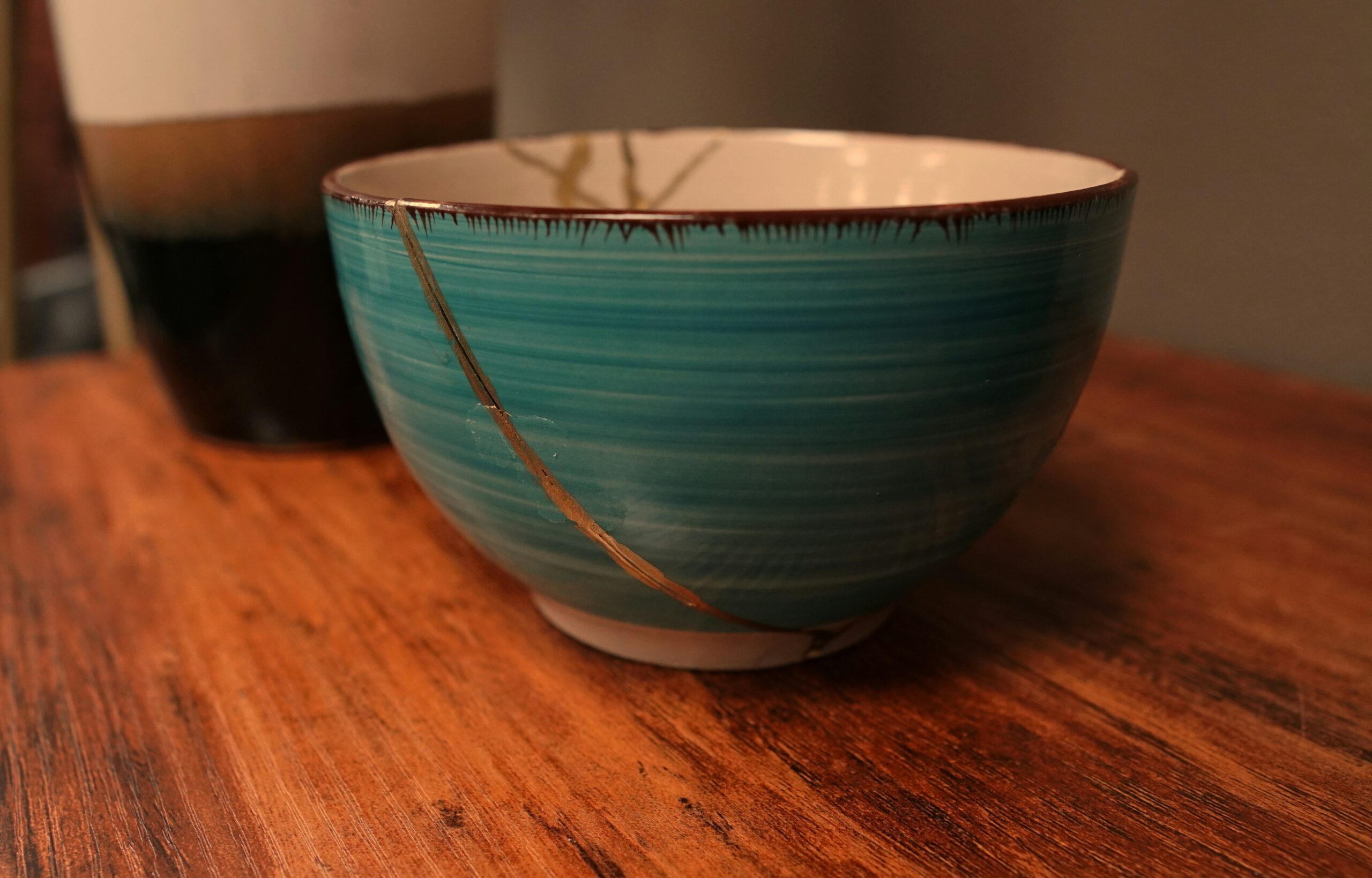🏺 When Broken Becomes Beautiful
Most of us are taught to hide damage — fix it fast, smooth it over, pretend it never happened. But in Japan, there’s an art form that does the opposite. Kintsugi (金継ぎ), meaning “golden joinery,” celebrates the cracks. Instead of disguising them, it fills them with gold, silver or platinum, turning what was once broken into something extraordinary.
In a world obsessed with perfection, Kintsugi stands as a quiet act of rebellion. It says: this object has lived. Its scars are not flaws — they’re proof of resilience.
Let’s explore how Kintsugi began, what it symbolises, and why it resonates so deeply today.
🪶 A Short History of Kintsugi
Kintsugi is thought to have originated in 15th-century Japan when shogun Ashikaga Yoshimasa sent a damaged tea bowl to China for repair. It came back crudely stapled together with metal pins — functional, but ugly.
Dissatisfied, Japanese artisans sought a more harmonious approach, using urushi lacquer mixed with gold dust to restore the bowl. The result wasn’t just a repair — it was a revelation. The cracks gleamed like lightning, transforming imperfection into art.
Over time, this philosophy became intertwined with Wabi-Sabi — the appreciation of imperfection, transience, and authenticity. In the tea ceremony, Kintsugi pieces came to symbolise humility and the beauty of impermanence (mujō).
✨ The Philosophy Behind the Gold
Kintsugi is more than mending — it’s meaning. Each repaired line represents an acceptance of time and change.
Its core principles:
- Imperfection is not failure. Cracks tell stories of use, love, and history.
- Repair adds value. What’s been broken and restored becomes stronger and more precious.
- Nothing is permanent. Everything changes; the art is in how we respond.
These ideas go beyond pottery. Kintsugi is a metaphor for healing — emotional, mental, even societal. It encourages us to wear our scars proudly instead of hiding them.
🌿 Wabi-Sabi — The Beauty of Imperfection
To understand Kintsugi, you need to meet its philosophical cousin: Wabi-Sabi.
Wabi-Sabi celebrates the imperfect, the incomplete, and the impermanent. It’s the crack in the cup, the weathered door, the leaf curling at its edge — the beauty that comes from authenticity, not polish.
When you apply that mindset to Kintsugi, the act of repair becomes a kind of mindfulness. It’s not about erasing what’s happened; it’s about honouring it.
As the tea masters say:
“A bowl that’s been broken and mended shines brighter than one that’s never known use.”
🧵 Kintsugi as Emotional Healing
It’s no surprise that Kintsugi has become a powerful metaphor in modern psychology. Many therapists and artists use it to explore resilience, trauma, and recovery.
- For grief: Repairing a broken object mirrors the process of slowly piecing life back together.
- For anxiety or burnout: The slow, careful restoration offers mindfulness and focus.
- For self-worth: It reframes flaws as part of your unique story — not something to hide.
You could even call it creative therapy. Mending with intention helps externalise emotional repair — a tangible act of healing.
🪙 Traditional vs. Modern Kintsugi
Traditional Kintsugi uses urushi lacquer (from the sap of the lacquer tree), gold dust, and days of curing time. It’s beautiful but complex — and not always safe for casual use, as the raw lacquer can irritate skin.
Modern makers often use epoxy resin or food-safe alternatives tinted with gold powder or mica pigment. These offer a similar aesthetic without the need for specialist materials or training.
The process remains the same in spirit:
- Clean and align the broken pieces.
- Apply your bonding agent (lacquer or resin).
- Dust or mix in gold pigment to highlight the joins.
- Let it set slowly — patience is part of the ritual.
The goal isn’t perfection — it’s harmony.
🌸 Why Kintsugi Resonates Now
We live in an era of disposable everything — from fast fashion to fleeting trends. Kintsugi feels like an antidote to that.
It invites us to:
- Value longevity over replacement.
- Honour our possessions instead of discarding them.
- Accept change as part of beauty, not the end of it.
There’s a quiet sustainability woven into its philosophy too: mend, don’t replace. Every repaired object is one less thing in landfill — one more thing given life again.
💡Everyday Kintsugi
You don’t have to break pottery to live by Kintsugi’s values.
- In relationships: Repairing misunderstandings with honesty and grace adds strength.
- In work: Admitting mistakes and learning from them builds integrity.
- In self-care: Recognising our own cracks — and tending to them gently — helps us grow.
Kintsugi is less about gold and more about mindset: resilience, gratitude, and the quiet courage to rebuild.
🧘 A Ritual of Reflection
For many practitioners, the act of mending becomes a meditative ritual. You slow down, breathe, and focus on precision. Watching the gold fill each fracture can be profoundly symbolic — a moment to acknowledge pain and transformation at once.
Some people even perform “metaphorical Kintsugi” — writing about their life’s cracks and how they’ve mended, painting golden lines over words to visualise growth.
Kintsugi teaches us that beauty doesn’t come from perfection — it comes from resilience.
The next time something breaks — a plate, a plan, or even your own sense of calm — don’t rush to discard or conceal it. Take a breath. Look at the fracture. And imagine what gold you might fill it with.
Because maybe the most precious things aren’t flawless — they’re the ones that survived.

Comments are closed